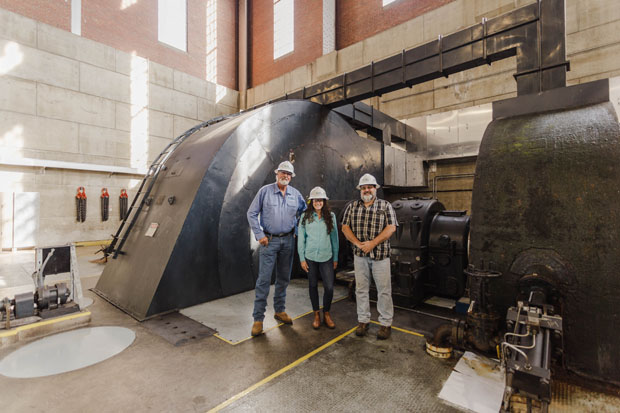The Power of Water in Western North Carolina
02 Dec 2022
Duke Energy’s current and future use of hydroelectric energy in the region, Part Two
By BEN WILLIAMSON, Duke Energy
Photos by CHELSEA CRONKRITE

In Part One (Oct/Nov issue), Ben Williamson explained the history of hydroelectric energy in western North Carolina, including its profound impact on World War II. Initially the hydroelectric sites served the primary function of electric generation. However, as Duke Energy worked to relicense each of these products, the objectives broadened. Part Two discusses the public and its interests, and how Duke Energy plans to proceed in the FERC relicensing process. Hydro power allows Duke Energy to both provide electricity and support communities.
Duke Energy’s hydro projects now operate under FERC licenses with certain requirements that benefit the public and ensure public safety. FERC licenses come with an expectation for comprehensive development and use of the waterway.
Each license regulates how the utility operates. For example, there are maximum and minimum lake level limits along with times and flow rates for scheduled recreational flow releases. Duke Energy maintains a website, www.duke-energy.com/lakes, where all this information can be found. The lakes also help manage flooding events, and the stations help the company prepare and respond to them.
These FERC licenses also require applicable water quality standards to be met, preservation and creation of aquatic habitats, protection of cultural resources and more.
The recreation component of these projects is never more apparent than in western North Carolina. An entire industry relies on the predictable recreation flow releases, and the lake and river access areas required by the licenses and stakeholder agreements. Visits to the river and lakes have only increased in recent years as people rediscovered the outdoors during the COVID-19 pandemic.
Benefits to the habitat and environment are also provided by these hydro stations.
“We are having to adapt to all the changes that come along with new licenses. The amount of work that it takes to meet license requirements is so much different now. People used to not care about the effects of lake levels, water quality, and recreaction flow releases. Twenty-five years ago, Bear Creek Lake had a few homes; now it has dozens,” said Allen Nicholson, lead engineering technologist for 11 of Duke Energy’s hydroelectric plants throughout the Blue Ridge Mountains.
“You used to go up to these lakes, like Lake Glenville and Nantahala Lake, and they were empty. You would see maybe one or two docks. Now there is a dock on every lot,” said Kevin Holland, a Duke Energy Lake Services representative and Franklin native. “These lakes have brought people here. They were the hidden gems. Then people discovered how pretty the lakes were and wanted to move here. These pristine, beautiful lakes would not exist without our hydro plants.”
“Duke Energy is proud to support some of the best public recreation around my community. Whether it is a summer visit to The Pines swim beach (Lake Glenville), casting a reel at Wishons Fishin' Hole (Nantahala River) or paddle-boarding on Bear Creek Lake, there are endless possibilities to enjoy,” said Sarah Korellis, a Cashiers local and a generation project engineer manager for Duke Energy. Korellis has been with the company for six years.
Economic Impact
“I grew up here. I am confident that this region wouldn’t look this way today without this system of hydro stations. The growth around the lakes, the growth around the rivers. I couldn’t have imagined how much growth came from this,” said Phil Postell, who oversees operations at Thorpe Hydro Station. “I grew up with these plants. My grandfather helped drill the tunnels for these systems. This career chose me. I first saw an ad in the paper, and I wanted to work in the Nantahala powerhouse.”
Without energy, there is no economy. Without power, there is no progress. Electricity remains a basic functional need for the growth and development of the region.
Duke Energy worked with federal, state and local agencies, along with lake neighbors and river stakeholders to adapt operations to optimize the electric generation of the stations, while also ensuring the public interests are met.
“We understand the economic impact we have outside of energy generation and our role in being a good neighbor,” said Preston Pierce, the General Manager for Duke Energy’s 11 hydroelectric plants that sit in the western footprint.
Upgrading Hydro Stations
“Hydro is the cleanest and most efficient way to produce electricity. We are spending lots of money to bring these hydros up to date and into the 21st century, making them even more efficient,” said Nicholson.
Duke Energy additionally spends time and resources ensuring its plants are as safe and environmentally protective as possible, constantly investing to replace gates, hoists, valves, transformers and more.
“We are consistently committing resources for projects that will increase the reliability, efficiency and lifespan of these plants. For me, it is gratifying to also see how these projects increase the safety and enviormental benefit of these plants,” said Korellis.
At Bad Creek Pumped Storage Station in Salem, SC, the four power turbines are being upgraded to increase capacity. A similar project was just completed on the turbine at Tennesee Creek Hydro Station in Tuckasegee, NC, and plans to increase the generation capacity of many other hydro units are in the works.
“There is still a lot of value in these plants,” said Postell.
The Future
Duke Energy is leading one of the most ambitious clean energy transformations in the industry, targeting 70% reduction in carbon dioxide emissions levels by 2030 in the Carolinas and net-zero carbon emissions by 2050.
Hydroelectric energy plays an important role in that transition.
“The hydro generation in western North Carolina really was the original renewable energy and the foundation for the company as it expanded into coal, nuclear and gas in the 20th century. Duke Energy is committed to a diverse energy mix that will include hydro, solar, wind, new nuclear and batteries, all of which provide a foundation for a cleaner energy future,” said Lisa Leatherman, a Duke Energy community relations manager.
As the company continues to add solar and wind generation, which are intermittent sources depending upon the weather, complementing them with reliable and quick-starting generation assets will be critical. Duke Energy’s fleet of hydroelectric plants ensures customers have reliable and affordable energy when they need it.
“The transmission lines and hydroelectric units really created the early backbone that Duke Energy now uses for the region's transmission and distribution as well as supporting our grid optimization work,” said Leatherman. “We are working on new self-healing grid technology to increase the resiliency and reliability for the customers we serve throughout the Carolinas. That technology couldn’t have been envisioned when these hydros were first created, but even our most advanced technology builds upon the infrastructure put in place here a century ago.”
The company started as a hydroelectric company, and that history will continue to be a vital part of Duke Energy’s overall generation profile.
“If you want to live here, you have to be a good neighbor and I think Duke Energy has been a good neighbor. The need for a reliable power supply cannot be overstated. It is the basis of almost everything,” said longtime Duke Energy engineer Jerry DeWeese.
* * * * * * * *
FERC is the Federal Energy Regulatory Commission, which is the agency that regulates the transmission and wholesale sale of electricity and natural gas in interstate commerce. Of the 28 hydroelectric stations that Duke Energy owns and operates, 11 sit within about two hours of Cashiers. Seven of those exist within four different licenses regulated and enforced by FERC.













